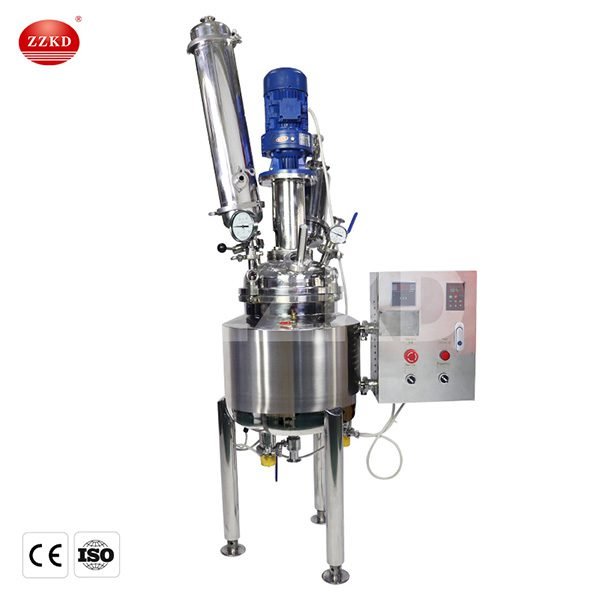Last Updated on March 1, 2023 by admin
Stainless steel jacketed reactor vessel used for cooling/warming. A response vessel is a holder with a fomenter for blending, scattering and response of various materials in compound creation. It is broadly utilized in synthetic food, drugs, gum, covering, paint, and printing ink.
The properties of tempered steels liked for atomic reactor pressure vessel development, the austenitic-chromium-nickel types, are assessed alongside different bases for this atomic application. The designing models lay out the cutoff points for plan and activity, the different parts of vessel creation and the ramifications of the ecological impacts, radiation and consumption.
Table of Contents
Stainless Steel Reactors:
Handling of synthetic compounds opens process gear to exceptionally destructive liquids. Cautious examination of liquids, tensions, cycles and assembling temperatures have demonstrated a jacketed stainless steel reactor to be profoundly consumption safe in very brutal conditions.
Legitimate thought reactors must be given with the impacts of the science on the material. Furthermore, for development during the assembling system; any other way, the condition can quickly decline, prompting hardware erosion and at last imperil the cycle line.
Detail of stainless steel jacketed reactor as the material of development for Reactors offers a long haul, practical technique to forestall harming consumption.
Benefits of Stainless Steel Reactors:
Jacketed stainless steel lab reactors are profoundly practical over the whole life pattern of the hardware. Appropriately kept up with, TITAN’s Jacketed Stainless Steel Reactors can work for quite a long time, making them an exceptionally efficient material determination over other accessible metals.
- Convey numerous long stretches of efficient assistance in life
- Wipe out costly free time because of hardware disappointment
- Give remarkable consumption opposition
- Oblige high steam pressure
- Give high protection from uniform assault
- Give exceptionally restricted erosion obstruction
- Forestall pressure breaking
- Limit prospects of cycle liquid breaks
These characteristics have prompted acknowledgment and development of the utilization of Jacketed Stainless lab Reactors, Pressure Vessels, Columns, Storage Tanks, Heat Exchangers, Pipe and Piping Systems in sulfuric corrosive handling, creation of urea and different manures.
Valuable Execution:
Stainless steel jacketed reactor’s valuable execution is owing to a mix of austenitic and ferrite combinations in its microstructure, accomplishing both strength and high erosion obstruction. The industry is continually searching for profoundly dependable materials with their heap applications. Plant tasks generally support stainless steel lab reactor. The board and upkeep experts value their durability and capacity to endure the exceptionally forceful liquids inborn.
Contrasted and a few different materials, Jacketed Stainless Steel is a dependable and, in the long haul, a less expensive material of development, offering high strength even in profoundly requesting applications.
It ought to be noticed that because of the extents of austenitic and ferrite composites, Jacketed Stainless Steel requires impressively more consideration in welding planning and creation systems. Freshness or not exactly watchful regard for the particular welding cycle can deliver the subsequent manufacture compromised in strength and consumption opposition.
Glass Lined Reactor:
The glass-lined reactor in the substance and drug area, a glass-lined reactor, is utilized given its similarity with many synthetics. The reactor is a vessel with a fomenter that permits blending synthetic compounds in a contained climate. The reactor can be compressed and work in a scope of temperatures. The top segment of the reactor permits the cycle spouts to an interface that gets the synthetic substances and gases as fitting and considers cleaning head spouts. They have various sizes yet commonly range from 63 liters to 16000 liters.

Benefits of Glass-Lined Steel:
The composite metal/glass material of development gives the advantages of both essential parts. The outer steel development offers strength, while the interior glass lining gives almost general erosion insurance and a smooth non-debasing surface. The consequence of this is:
- Consumption protection from the two acids and bases
- High working temperatures and tensions
- Capacity to add or eliminate intensity to the cluster
The most common way of manufacturing glass-lined steel hardware (which you can peruse more in our post on How Glass-Lined Vessels are Made) is to wire the glass to the steel. This bond is an area of strength for exceptional strength of around 16,000 psi (like that of pre-pushed concrete!).
Conclusion:
Glass Lined reactors are utilized for completing basic compound cycles where consumption obstruction and synthetic idleness are of basic significance. While vital in the business, steel reactors have numerous downsides contrasted with glass-lined choices.

























